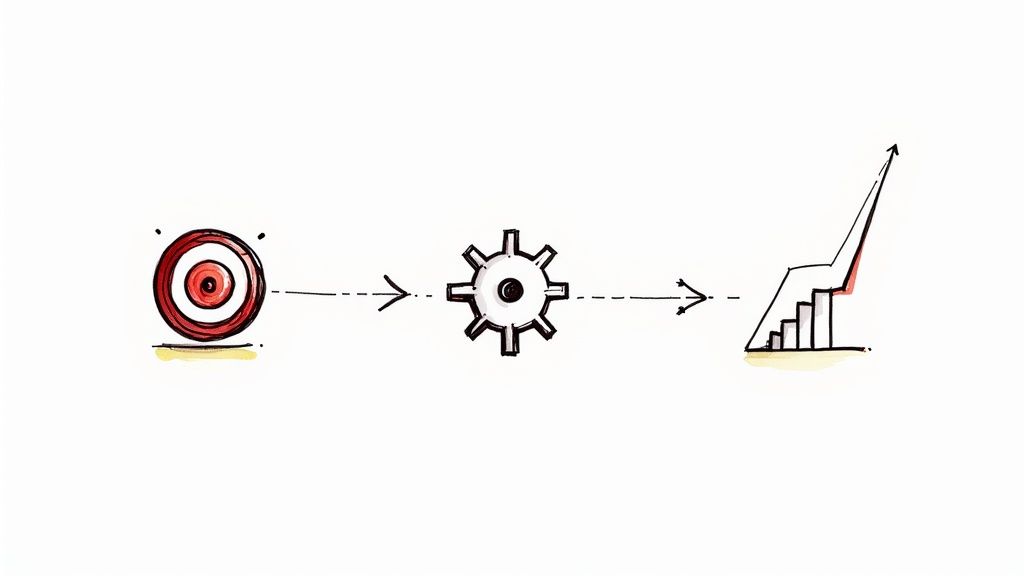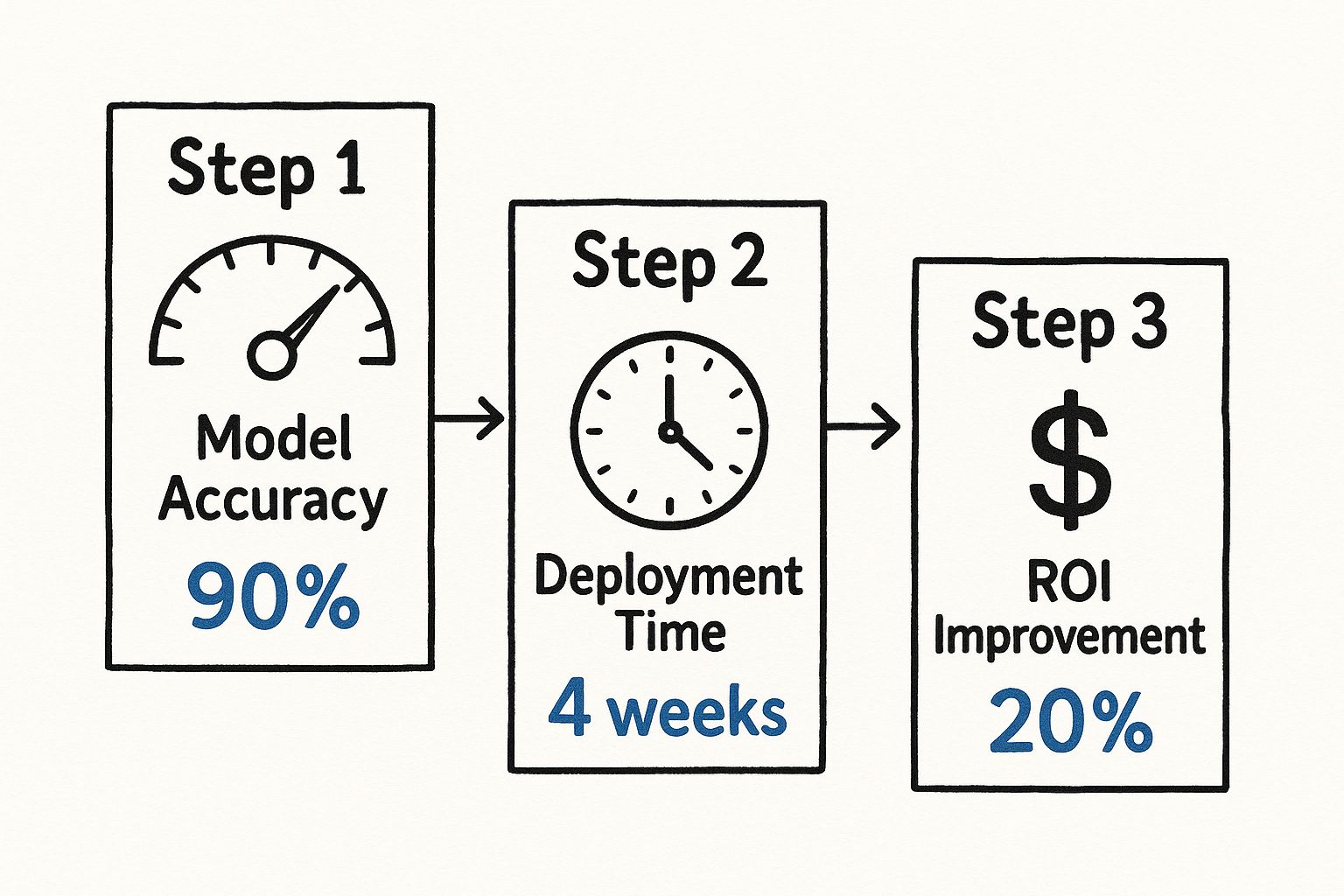Your Guide to a Winning AI Strategy
Build a winning AI strategy that drives real business growth. Learn our step-by-step framework for implementation, from use case selection to measuring ROI.

An AI strategy is simply a detailed plan that connects your investment in artificial intelligence directly to your core business goals. It’s not about grabbing the latest shiny AI tool off the shelf; it's about making deliberate choices to invest in solutions that deliver real, measurable growth, boost efficiency, and give you a genuine competitive edge.
Why an AI Strategy Is Your New Business Compass
Let's be honest, staring at the vast world of AI can feel overwhelming. Plenty of businesses are dipping their toes in the water, experimenting with new tools. But very few have a clear map to turn those exciting experiments into actual profit. That's why a formal AI strategy has shifted from a "nice-to-have" to your essential business compass for navigating the future and, crucially, avoiding wasted resources.
Think of it like this: jumping into random AI projects is like buying top-of-the-line hiking gear with no destination in mind. You might have the best tools on the market, but without a map and a trail, you’re just wandering aimlessly in the woods. A solid strategy, often developed through collaborative efforts like AI co creation, makes sure every single step you take brings you closer to your ultimate business objectives.
Beyond the Hype: The Real Risks of Falling Behind
Failing to create a formal strategy isn't just a missed opportunity—it's a serious business risk. In fiercely competitive markets, particularly within industrial hubs like Germany, the cost of standing still is incredibly high. Companies that are still relying on gut feelings are quickly finding that their competitors, armed with a clear plan, are pulling away.
Without a strategy, you're opening yourself up to:
- Wasted Investment: Pouring money into AI tools that seem exciting but don't actually solve a core business problem.
- Siloed Efforts: Different departments launching their own AI projects that clash with each other, creating data chaos and duplicated work.
- Missed Opportunities: Lacking the framework to spot and prioritise the most valuable real-world use cases for your unique business.
- Operational Gridlock: Trying to shoehorn new AI systems into old workflows, which often ends up causing more headaches than it solves.
A well-defined plan is what guides smart investments, channels resources where they matter most, and fuels innovation that actually moves the needle. It brings the clarity you need for long-term success, transforming reactive fire-fighting into proactive, strategic growth. This is the core purpose of dedicated AI strategy consulting.
From Reactive Moves to Proactive Wins
Ultimately, a powerful AI strategy shifts your entire organisation from a reactive posture to a proactive one. Instead of constantly playing catch-up, you start anticipating market changes and getting ahead of customer needs. As we explored in our AI adoption guide, this forward-thinking mindset is what truly separates the leaders from the followers.
This strategic direction gives a clear, unified answer to the big questions your leadership team is asking. It defines why you are pursuing AI, what specific problems it is meant to solve, and how you will concretely measure success. It’s the foundational document that aligns everyone from the C-suite down to the development teams, ensuring every project, every hire, and every euro spent on technology serves one primary mission: the success of the business. With the guidance of our expert team, you can build a compass that doesn't just point towards the future—it shows you how to get there.
The Building Blocks of a Powerful AI Strategy

So, what does a great AI strategy actually look like on the inside? It’s much more than just a boardroom decision to "start using AI." A truly effective strategy is a detailed, practical plan made up of distinct, interconnected pieces. Getting these foundational components right is what separates successful AI adoption from costly, dead-end projects.
Think of it like building a house. You wouldn't dream of putting up walls before pouring a solid foundation and erecting a strong structural frame. Each part of your AI strategy serves a similar purpose, providing the stability and direction needed to support your ambitions. If you ignore any one of these pillars, the whole structure could become wobbly.
A comprehensive AI strategy framework is the master blueprint that holds these pillars together, turning abstract goals into a concrete, actionable plan. This ensures every element works in harmony, all pulling in the same direction.
The Five Core Pillars of Your AI Strategy
Let's break down the essential components that every robust AI strategy must have. As we go through them, think about how each one applies to your own organisation. Your answers will form the very heart of your strategic plan.
1. Vision and Business Alignment
This is your 'North Star'. It’s the single most critical piece because it ties every AI-related action back to a real business result. Without it, you're just experimenting with technology for its own sake, which can get expensive fast.
The goal here is to define why you are investing in AI and what specific, measurable business goals it will help you achieve. Ask yourself: what are our top three business challenges or opportunities, and how can AI realistically help us improve revenue, boost efficiency, or delight our customers?
2. Data Infrastructure and Governance
Data is the fuel for almost all AI systems. The success of your machine learning models and other initiatives will depend directly on your ability to collect, manage, and use high-quality data. It's a massive hurdle; a recent study found that only 35% of companies have a formal AI strategy, and a major reason for the delay is a lack of data readiness.
You need to ensure your data is clean, accessible, secure, and ready for AI systems to consume. The key question is: do we have the right data to solve our target problem, and is it organised in a way an AI model can actually use? What rules do we need to put in place to govern this data?
3. Talent and Skills Development
Even the most sophisticated AI tools are useless without skilled people to build, manage, and refine them. Your strategy has to account for the human side of the equation. You need a clear plan for how you’ll acquire or develop the necessary expertise within your teams.
This means identifying the skills your team needs and creating a plan to fill any gaps through training, hiring, or strategic partnerships. A good starting point is to ask: what specific AI-related skills, like data science or machine learning engineering, are we missing? And what’s our plan to either upskill our current team or recruit new talent?
"Culture eats strategy for breakfast. We can teach you all we can about strategy... But if you don’t understand the cultural aspects—the organisational aspects of change—then your best strategies will just simply not work." - Karim R. Lakhani, Harvard Business School Professor.
4. Ethical Guidelines and Risk Management
As AI becomes more deeply woven into business operations, its ethical implications become more significant. Tackling issues like data privacy, algorithmic bias, and transparency right from the start isn't just a box-ticking exercise. It's essential for building trust with your customers and avoiding long-term damage to your reputation.
Your focus should be on establishing clear, unwavering principles for the responsible and transparent use of AI. Ask: what ethical guardrails do we need to make sure our AI systems are fair, transparent, and protect our customers' privacy?
5. Measurement and Performance Tracking
Finally, you have to know if any of this is actually working. This involves setting clear Key Performance Indicators (KPIs) that look beyond technical metrics to measure genuine business impact.
You must define how you will measure success and track the return on your AI investments. The ultimate question is: what specific metrics—like a reduction in operational costs or an increase in lead conversion rates—will prove that our AI initiative is delivering real, tangible value?
To tie it all together, here is a quick summary of these foundational pillars. Thinking through each of these areas is the first step toward building a strategy that delivers results.
Key Pillars of an Effective AI Strategy
A summary of the essential components required to build a comprehensive and actionable AI strategy for any organization.
| Pillar | Core Focus | Key Question to Ask |
|---|---|---|
| Vision & Business Alignment | Defining why you are using AI and connecting it to measurable business outcomes. | How can AI realistically address our top business challenges to improve revenue, efficiency, or customer satisfaction? |
| Data & Governance | Ensuring you have clean, accessible, and secure data ready for AI systems. | Do we have the necessary data to solve our target problem, and is it structured in a way an AI model can use? |
| Talent & Skills | Identifying the skills your team needs and creating a plan to fill gaps. | What specific AI-related skills do we lack, and what is our plan to upskill our team or recruit new talent? |
| Ethics & Risk Management | Establishing clear principles for the responsible and transparent use of AI. | What ethical guardrails do we need to ensure our AI systems are fair, transparent, and protect customer privacy? |
| Measurement & Performance | Defining how you will measure success and track the return on your AI investments. | What specific metrics will prove that our AI initiative is delivering tangible value to the business? |
By deliberately addressing each of these five pillars, you move away from vague aspirations and toward a structured, practical plan that stands a genuine chance of success.
Understanding the German AI Landscape

If you're doing business in Germany, you can't just copy and paste a generic AI strategy. It simply won't cut it. To get any real traction, your plan has to be built on the specific realities of the German market—a unique mix of incredible opportunities, deep-rooted strengths, and some very particular challenges.
Getting a handle on this local context is the first, non-negotiable step in any serious AI strategy consulting effort. It’s what ensures your roadmap is designed for the world you actually operate in, not a theoretical one.
Germany's AI ecosystem is a bit of a paradox. On one side, you have world-class research institutions and ambitious government-backed projects like Cyber Valley in the Stuttgart-Tübingen region. This initiative is a brilliant example of connecting top-tier academic research with industry heavyweights, all with the goal of turning pure science into practical, market-ready solutions.
But on the other side, that research excellence doesn't always find its way into widespread business practice. Many German companies, especially within the powerhouse Mittelstand and core manufacturing sectors, have been hesitant to fully embrace AI in their daily operations. This has created a clear gap between what's possible and what's actually being done.
Navigating Germany’s Unique Challenges and Opportunities
The OECD’s Artificial Intelligence Review of Germany shines a spotlight on this exact issue. The report confirms that while Germany’s research foundation is solid, its industry is lagging behind other European leaders when it comes to actually using AI. This is particularly true for manufacturing, the very heart of the German economy.
So, what's holding things back? Key challenges include a scarcity of venture capital for new AI start-ups, a business culture that can be risk-averse when it comes to disruptive change, and specific workforce skill gaps. For German businesses, this slower pace of adoption isn't just a missed opportunity; it's a genuine risk to their global competitiveness and supply chain strength. The report also highlights a significant AI skills shortage, which is a major bottleneck despite the country's strong educational system.
This fragmented and relatively slow AI adoption contrasts sharply with Germany's powerful research output. It underscores a clear need for intensified efforts in policy, funding, and skills development to bridge the gap between innovation and industrial application.
This situation isn't a dead end, though. Far from it. It’s a call for a much smarter, more focused AI strategy. What it really means is there's a massive, untapped opportunity for businesses that can figure out how to bridge this gap. Companies that successfully blend traditional German engineering excellence with agile AI implementation are poised to dominate their markets. Your strategy needs to be crafted to sidestep these specific hurdles while capitalising on the immense underlying strengths of the German economy.
Tailoring Your Strategy for the German Market
What does this all mean for your business on a practical level? A winning strategy has to be carefully tailored to this environment. It's about focusing on applications that deliver clear, immediate value—a crucial element for overcoming any cultural caution.
Here’s what your approach should prioritise:
- Solve Practical Problems: Forget about abstract, "moonshot" projects for now. Instead, use AI to tackle tangible issues your business faces today, like predictive maintenance, quality control, or supply chain optimisation.
- Leverage Existing Strengths: Build on Germany's industrial might. Use AI to enhance and augment the precision engineering and quality that German manufacturing is famous for, not replace it.
- Invest in Strategic Upskilling: Address the skills gap head-on by investing in targeted training for your current team. This builds in-house capability and fosters a culture where people are comfortable with new technology.
- Demonstrate a Clear ROI: Frame every AI initiative around a solid business case with measurable returns. When the value is undeniable, it’s much easier to get stakeholders on board.
By truly understanding these local nuances, your AI strategy stops being a theoretical document and becomes a practical, actionable guide to succeeding in the German market.
A Step-by-Step Framework for Building Your AI Strategy
So, how do you go from the idea of an AI strategy to a real, working plan? It can feel like the toughest part of the whole process. But the key is to break it down into manageable phases. This isn't about writing some massive, five-year document on day one. It's about creating a repeatable process to find, test, and grow AI opportunities in a smart, structured way.
This practical approach, which we support with tools like our AI Strategy consulting tool, is designed to turn those big goals into a clear roadmap. The whole journey can be organised into four distinct phases, each with its own focus and crucial actions.
Phase 1: Discovery and Assessment
Before you can build anything, you have to know where you stand. This first phase is all about looking inward. The goal here is to get a crystal-clear picture of your business challenges, what your tech can already do, and how good your data really is. After all, you can't plot a course if you don't know your starting point.
During this stage, you're looking for answers to some fundamental questions:
- Business Needs: Where are our biggest operational headaches or growth opportunities? Are we losing time, money, or our competitive edge somewhere?
- Technical Readiness: What do our current tech stacks and data systems look like? Are we actually ready to support AI, or are there gaps we need to fill first?
- Data Maturity: Do we have access to clean, reliable data for potential AI projects? This is critical—poor data is one of the top reasons AI initiatives fail.
Doing this homework grounds your strategy in reality. It’s what stops you from chasing exciting ideas that are ultimately impractical to implement.
Phase 2: Use Case Identification and Prioritisation
Once you have a solid grasp of your needs and capabilities, you can start pinpointing specific problems AI could solve. This is where you get down to the nitty-gritty. The aim isn’t to create a laundry list of every possible AI application, but to find a few high-impact, achievable projects to kick things off.
A great technique here is to use an AI requirements analysis tool or a similar structured method to vet your ideas. For every potential use case, you should evaluate it against two main criteria: business value and feasibility. This disciplined approach helps you focus on projects that are not only worthwhile but also doable with your current resources.
The secret to gaining momentum is to start small, prove value quickly, and then scale success. By prioritising a pilot project that can deliver a measurable win, you build the business case and internal support needed for more ambitious initiatives down the line.
Phase 3: Roadmap Development and Execution
With a high-priority use case chosen, it's time to build the project plan. This is the roadmap phase, where your strategy turns into a real-world schedule with clear milestones, assigned resources, and defined responsibilities. This is where the abstract concept of an AI strategy becomes something tangible you can act on.
The key elements of a strong roadmap include:
- Clear Milestones: Set specific, time-bound checkpoints for the project, from data preparation and model development right through to deployment.
- Resource Allocation: Assign the budget, people, and technology needed to hit those milestones.
- Success Metrics (KPIs): Decide exactly how you'll measure success. These should be business-focused metrics, like a percentage drop in processing time or a boost in customer satisfaction scores.
This infographic shows a typical flow for a pilot project, connecting model performance directly to deployment speed and financial returns.

The image highlights how a technical achievement, like 90% model accuracy, can translate directly into a tangible business outcome, such as a 20% improvement in ROI within a set timeframe.
Phase 4: Governance and Continuous Improvement
Finally, a great AI strategy isn't a one-and-done deal; it's a continuous cycle. This last phase is all about putting the governance and processes in place to manage, monitor, and scale your AI work for the long haul. This is what will make your strategy last.
This involves setting up the right teams and review meetings to oversee AI projects, manage risks, and make sure you're following ethical guidelines. It also means creating a feedback loop where you take what you learn from early projects and use it to inform the next wave of ideas. A structured approach, supported by an effective AI strategy framework, ensures your organisation can adapt and thrive as your business—and the technology—evolves. For ongoing success, consistent input from our expert team can provide invaluable guidance.
Bringing Your AI Strategy to Life with Real-World Examples
An AI strategy on paper is a great start, but its true power is only unlocked when it drives tangible results. Theory is one thing; seeing a plan translate into real-world efficiency, cost savings, or new revenue is what truly matters. This is where we move from the blueprint to the build, looking at how a clear plan turns technology into a genuine competitive advantage.
Choosing the right initial project is often where success begins. Many businesses, especially in markets like Germany, are still finding their footing with AI. In fact, research showed that in 2023, AI adoption among German companies sat at just 12%, a tiny one-percentage-point increase from 2021. This points to a cautious, almost hesitant integration, even with the explosion of powerful generative AI tools. It really underscores the need for a smart, targeted AI strategy that focuses on solving genuine business problems to prove its value and speed up adoption.
From Manufacturing Floors to Retail Checkouts
Let's look at how this plays out in industries central to the German economy. These examples aren’t just about plugging in new tech; they're about smart business decisions guided by a strategic framework.
A mid-sized manufacturing firm, a classic German Mittelstand company, was wrestling with persistent, costly downtime from unexpected machinery failures. Instead of their reactive, "fix-it-when-it-breaks" approach, their AI strategy zeroed in on one high-impact goal: predictive maintenance.
- The Strategy: To implement an AI model that could analyse sensor data from their production line equipment in real time.
- The Building Blocks: This demanded a clear vision (to slash downtime), a solid data infrastructure (collecting and cleaning sensor data), and defined success metrics (tracking uptime percentages and maintenance costs).
- The Result: The system started flagging potential failures weeks in advance. This simple shift allowed the maintenance team to schedule repairs during planned shutdowns, cutting unexpected downtime by over 30% and saving the company hundreds of thousands of euros each year. That initial win built the confidence and the business case to scale the strategy across other production lines.
Personalisation That Actually Builds Loyalty
Now, let’s consider a German e-commerce retailer facing intense competition from global giants. Their problem wasn't a lack of products but a real struggle to keep customers engaged and coming back. Their strategy centred on using AI to forge a deeply personal shopping experience.
The core idea was to move beyond generic, one-size-fits-all marketing and create a one-to-one relationship with every single customer. This required a strategic pivot from mass communication to individualised recommendations, all powered by machine learning.
The implementation wasn't treated as a one-off project but as a core strategic initiative. It started with a detailed analysis of what data was needed and how a new recommendation engine would mesh with their existing platform. The plan even included A/B testing different algorithms to see which models drove the best engagement and, ultimately, higher conversion rates.
The outcome? A dynamic storefront that adapted to each user's browsing history, purchase behaviour, and even the time of day they shopped. This AI-powered personalisation led to a 15% increase in average order value and a significant, measurable boost in customer retention.
These stories prove a critical point: a successful AI strategy isn’t about having AI; it’s about what you do with it. Every success story connects directly back to those foundational building blocks—a clear vision, solid data, and measurable goals.
Ready to brainstorm how these ideas could apply to your own business? A structured session can make all the difference. You can explore how to get started by checking out our AI strategy workshop. A clear plan is what turns powerful technology into your most valuable business asset.
How to Measure and Evolve Your AI Strategy

Let's be clear: an AI strategy isn't a static report you create once and then file away in a forgotten digital folder. It's a living, breathing plan that must adapt to survive. A truly great strategy is never 'done'; it’s a constant cycle of monitoring what's working, measuring the impact, and refining your approach based on what you learn.
Without this cycle, even the most brilliant plan will quickly become irrelevant as technology races ahead and business goals change. This is especially true in the current climate. In Germany, for instance, the generative AI market was projected to reach US$2.77 billion in early 2025, with some forecasts suggesting it could climb to an incredible US$15.70 billion by 2030. This kind of explosive growth, driven by hubs like Cyber Valley, shows just how fast the ground can shift beneath your feet.
Defining KPIs That Measure Real Business Impact
The first step in measuring your strategy’s success is to look beyond purely technical metrics. Yes, model accuracy is important to the data science team, but it doesn't tell the board whether the project is actually creating value for the business. Your key performance indicators (KPIs) must tie directly to tangible business outcomes.
Instead of getting bogged down in technical specs, focus on metrics that matter to the bottom line:
- Return on Investment (ROI): Are your AI initiatives bringing in more revenue or savings than they cost to build and run? It's a simple, but critical, question.
- Efficiency Gains: How much time are you saving? Are workflows faster or needing less human oversight? Think in terms of reduced call handling times or fewer hours spent on manual data entry.
- Market Share Growth: Is your AI-driven edge helping you capture a bigger piece of the pie from your competitors?
- Customer Satisfaction (CSAT): Are your AI-powered services actually making customers happier and more loyal? Check the feedback scores.
Establishing Review Cycles and Governance
A strategy only evolves if you build a formal process to guide it. This means setting up regular review cycles and putting a dedicated governance team in place. These structures are your guardrails, ensuring your AI roadmap stays aligned with the wider business strategy as it inevitably shifts.
An AI governance team isn't about creating red tape. It’s about creating accountability. It’s their job to make sure your AI projects stay on track, remain ethically sound, and are strategically relevant.
This team should get together quarterly or bi-annually to review performance against your chosen KPIs. Their role is to ask the tough questions. Are our initial assumptions still valid? Have new technologies appeared that we ought to be looking at? Do our priorities need to change?
It’s this constant refinement that turns a decent plan into a genuinely effective one. The lessons you learn from one project will inform the next, building a culture of continuous improvement across the organisation. If you need a hand navigating this ongoing journey, connecting with our expert team can help ensure your AI initiatives deliver sustained value for years to come.
Frequently Asked Questions About AI Strategy
Diving into the world of AI often brings up more questions than answers. It's completely normal. To help clear things up, we've tackled some of the most common queries we hear from business leaders who are just getting started.
For an even deeper dive, you can always explore our full AI strategy FAQ page.
How Do We Start an AI Strategy with a Limited Budget?
When you're working with a tight budget, the trick is to be smart and targeted. Don't try to boil the ocean. Instead, focus on high-impact, low-cost projects. A great first step is a focused requirements analysis to find a single, critical business problem that AI can solve without breaking the bank.
From there, launch a small pilot project with very simple, clear success metrics. The goal is to prove the concept's value. You can lean on cloud-based AI services and open-source tools instead of investing in expensive hardware. Once you show a tangible return on investment, even a small one, you'll have a much stronger case for a bigger budget to scale up.
What Is the Biggest Mistake in AI Strategy Development?
By far, the most common pitfall is chasing the latest shiny technology instead of solving a real business problem. Too many companies get swept up in the hype of a new AI tool and then try to shoehorn it into their operations, hoping for magic. This rarely works.
A truly effective AI strategy always starts with the business. First, identify your most pressing challenges or biggest opportunities. Then, and only then, do you explore whether AI is the right tool for the job. Without this business-first mindset, AI projects almost always fall flat and fail to deliver any real value.
How Long Does It Take to Build an Initial AI Strategy?
You can get a foundational AI strategy in place faster than you might think. Typically, this initial planning phase takes about four to eight weeks, depending on how large and complex your organisation is. This period covers the essential groundwork: discovery sessions, stakeholder interviews, building a roadmap, and setting clear goals.
Getting your first pilot project off the ground and showing initial results will usually take another three to six months. Remember, the goal isn't to create a perfect, rigid five-year plan from the get-go. It's about building a solid, agile AI strategy that allows you to learn and adapt as you go.
What Role Does Data Play in an AI Strategy?
Think of data as the fuel for your AI engine. Without it, you're going nowhere. You simply cannot have a successful AI plan without a rock-solid data strategy to back it up. Your plan has to outline exactly how you'll manage, collect, store, and secure your data.
Before you can even dream of training machine learning models, you need access to high-quality, relevant data. A crucial first step in any AI journey is to honestly assess your company's data maturity and fix any gaps you find. Get your data house in order before you start your first pilot.
Ready to move from asking questions to taking action? Ekipa can help you build a practical AI strategy that's tailored to your business, often in just 24 hours. Let our expert team help you turn your ideas into scalable impact.



